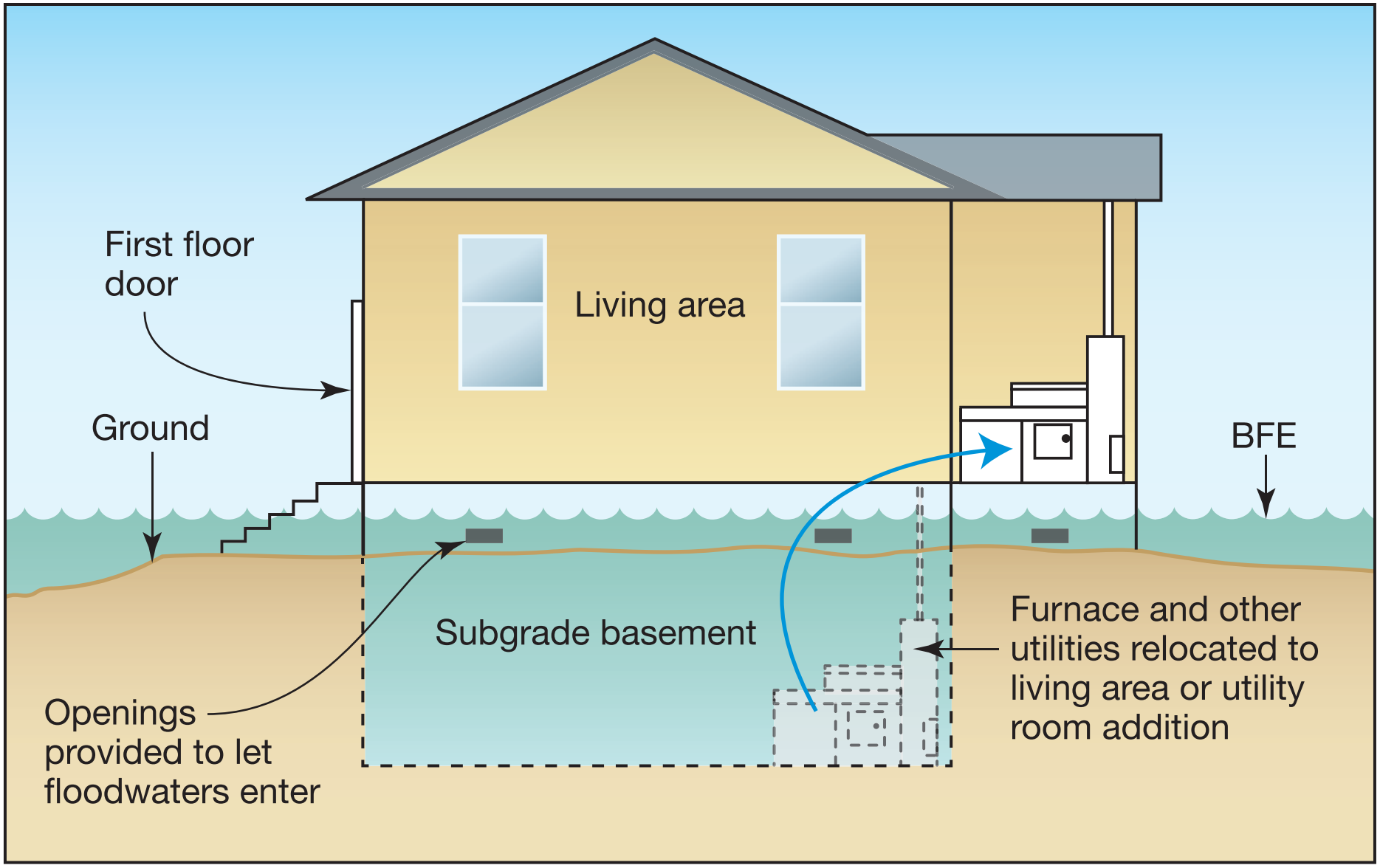Floodproofing
Install Wet Floodproofing
What Is It?

FEMA
Compared to dry floodproofing, which makes building and site modifications to prevent water from entering a flooding event, wet floodproofing involves making a series of modifications to a structure to allow an enclosed area below the base flood elevation (BFE) to flood through use of openings (e.g. vents) or breakaway walls, which are designed to break free from the building when subjected to flood forces. Allowing the building to flood will reduce internal and external hydrostatic pressure, reducing loads on walls and floors and lowering the risk of damage to the structure.
Wet floodproofing has several advantages over dry floodproofing. Wet floodproofing measures are usually cheaper than dry floodproofing measures in both new construction and retrofits. When design loads are exceeded in dry floodproofed buildings, severe structural damage may occur that could potentially cause greater damage than if the building were allowed to flood. However, wet floodproofed buildings may require extensive cleanup after a flooding event. Building contamination can occur if floodwaters carry sewage, chemicals, or other pollutants into the building. In addition, wet floodproofing has more limited applications and is usually only effective for buildings in A zones. Furthermore, wet floodproofing will not lower flood insurance premiums for any buildings, while some dry floodproofing measures will lower premiums for non-residential buildings.
Installation of flood openings must be combined with other wet floodproofing measures to minimize damage. Approved flood damage-resistant materials should be used in the floodable space (see NFIP Technical Bulletin 2 for material requirements), and building electrical and mechanical systems should be protected or elevated to upper floors above the BFE. Pumps can be installed to push water out of flooded areas, though this should not occur until after floodwaters have receded, as the hydrostatic pressure differential could cause basement walls to collapse.
Examples of other wet floodproofing practices:
- Anchoring fuel tanks
- Elevating outside air-conditioner compressor, inside furnace or air-conditioning unit, washer and dryer (choose front-loaders if on platform), water heater, freezer and electrical outlets and switches on strong shelves, legs, and/or raised platforms
- Put plastic sheeting or bags under your BFE appliances that can be pulled up around them if flooding occurs
Benefits
- Lowers risk of structural damage due to hydrostatic pressures being reduced by building flooding
- Cheaper than dry floodproofing in both retrofits and new construction
- In retrofits, building exterior appearance will not be significantly altered compared to dry floodproofing, helping to preserve building aesthetic
Drawbacks
- Wet floodproofing is only practical in some applications. Buildings in A Zones can benefit from wet floodproofing, but is not recommended for buildings in V Zones.
- Wet floodproofing can protect buildings from structural damage in floods but not the contents of the flooded area.
- Conversion of a ground floor enclosure and basement into approved floodable spaces and elevation of building mechanical/electrical systems reduce the amount of building space available.
- In retrofits, subgrade basements may need to be filled in to bring the building into compliance with FEMA standards.
- Does not significantly reduce potential damage from high-velocity flooding and wave action.
- Funds for flood mitigation generally cannot be used for wet floodproofing measures.
- Wet floodproofing does not reduce insurance premium rates for residential or non-residential structures.
Regulatory Impacts and Requirements
Potential regulatory touchpoints in Boston and Massachusetts include:
- Building Code/Permit
Other:
- Breakaway walls must be used in any enclosure below BFE in V zones to meet FEMA standards.
- Wet floodproofing can only be used to bring a substantially damaged or improved structure into compliance with floodplain management ordinances and laws if enclosed areas below base flood elevation are above grade on one side and are solely used for parking, storage, or building access.
- Wet floodproofing is not approved by FEMA for new construction or substantial reconstruction for structures in V zones. While breakaway enclosures can be used in V Zones, flood insurance premiums will be higher.
Financing Options, Incentives, and Rebates
- Hazard Mitigation Funding Under Section 406 of the Stafford Act: Local, state, tribal, and some non-profit facilities damaged by disasters may use Section 406 funding to restore damaged facilities, as well as undertake preventative measures for future flood mitigation.
- Small Business Administration Disaster Loan: Businesses of any size and most private non-profit organizations can apply for Business Physical Disaster Loans to cover disaster losses not fully covered by insurance. Improvements to mitigate future damage (i.e. wet floodproofing) may allow for a loan amount increase.
News
- “Rising Waters, Rising Concerns: Annapolis Town Hall Addresses Flooding,” Capital Gazette, July 2015
- “How New Homes Can Stand Up to Disaster,” Builder, January 2017
Resources
- FEMA: Wet Floodproofing
- Chapter 6: Wet Floodproofing from Selecting Appropriate Mitigation Measures for Floodprone Structures
- Flood Protection Measures
- Flood zones
- Coastal Construction Manual
- Anchor Fuel Tanks
- Resilient Design institute: Fundamentals of Resilient Design: Wet Floodproofing
- Climate Tech Wiki: Floodproofing
- City of New York: Designing for Flood Risk
- New York Times: A Guide to Flood-Resistant Building Terms
A Sample of Providers
- Many general building and mechanical systems contractors can provide wet floodproofing services. Coastal building contractors may have more experience with wet floodproofing projects.
- Smart Vent – Foundation flood vents


